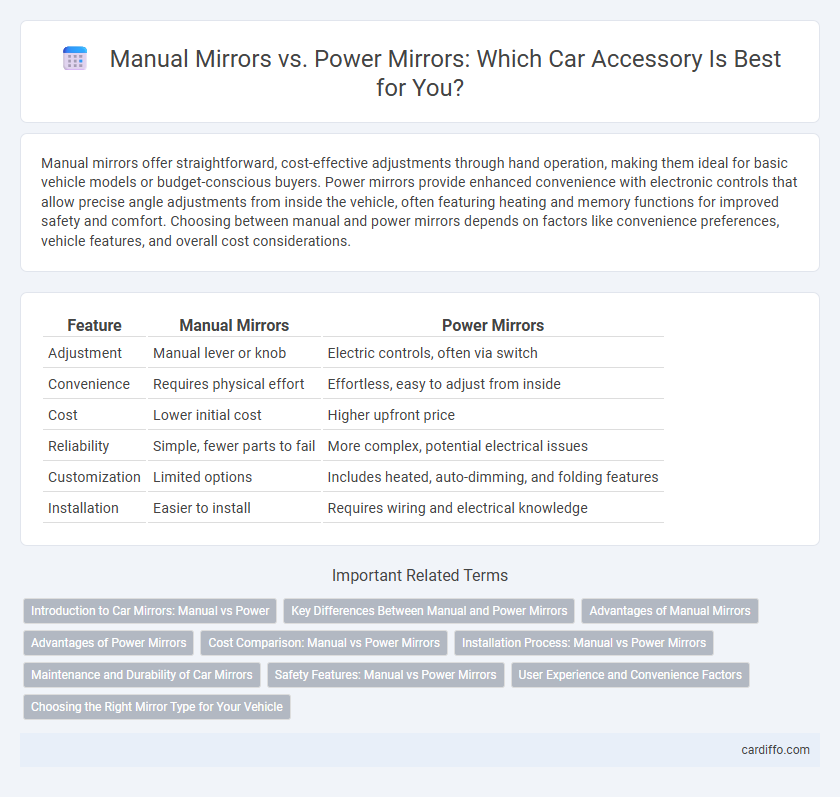Manual mirrors offer straightforward, cost-effective adjustments through hand operation, making them ideal for basic vehicle models or budget-conscious buyers. Power mirrors provide enhanced convenience with electronic controls that allow precise angle adjustments from inside the vehicle, often featuring heating and memory functions for improved safety and comfort. Choosing between manual and power mirrors depends on factors like convenience preferences, vehicle features, and overall cost considerations.
Table of Comparison
| Feature | Manual Mirrors | Power Mirrors |
|---|---|---|
| Adjustment | Manual lever or knob | Electric controls, often via switch |
| Convenience | Requires physical effort | Effortless, easy to adjust from inside |
| Cost | Lower initial cost | Higher upfront price |
| Reliability | Simple, fewer parts to fail | More complex, potential electrical issues |
| Customization | Limited options | Includes heated, auto-dimming, and folding features |
| Installation | Easier to install | Requires wiring and electrical knowledge |
Introduction to Car Mirrors: Manual vs Power
Car mirrors serve essential functions in vehicle safety, available primarily as manual and power variants. Manual mirrors require physical adjustment by hand, often found in older or budget vehicles, offering simplicity and cost-effectiveness. Power mirrors, equipped with electric motors controlled from inside the car, provide convenience, precise positioning, and advanced features like heating and automatic dimming.
Key Differences Between Manual and Power Mirrors
Manual mirrors require physical adjustment by hand, offering a simple and cost-effective option without reliance on vehicle electronics. Power mirrors utilize electric motors controlled from inside the vehicle, providing enhanced convenience, especially for drivers frequently adjusting mirrors for multiple users or driving conditions. Unlike manual mirrors, power mirrors often include features like heating, auto-folding, and memory settings, adding functionality and safety benefits.
Advantages of Manual Mirrors
Manual mirrors offer significant advantages such as lower cost and simpler installation compared to power mirrors. They require no electrical components, reducing potential maintenance issues and enhancing long-term reliability. Their lightweight design also improves vehicle efficiency by minimizing additional electrical load.
Advantages of Power Mirrors
Power mirrors offer enhanced convenience by allowing drivers to adjust mirror positions electronically without needing to stop or reach outside the vehicle. They improve safety through features like heated elements that prevent fog or ice buildup and integrated blind-spot detection systems. These advanced functions provide superior visibility and quicker response to driving conditions compared to manual mirrors.
Cost Comparison: Manual vs Power Mirrors
Manual mirrors generally cost significantly less than power mirrors due to simpler mechanical components and easier installation processes. Power mirrors involve motors, wiring, and electronic controls, which increase both the initial purchase price and potential maintenance expenses. Choosing manual mirrors offers a budget-friendly option, while power mirrors provide convenience at a higher cost.
Installation Process: Manual vs Power Mirrors
Manual mirrors require a simpler installation process involving basic tools and direct mechanical adjustments, making them easier to install for most vehicle owners. Power mirrors demand a more complex installation that includes electrical wiring, integrating control switches, and sometimes programming with the vehicle's electronic system. Proper installation of power mirrors ensures functionality of features like remote adjustment, heating, and signal integration, which are absent in manual mirrors.
Maintenance and Durability of Car Mirrors
Manual mirrors require minimal maintenance due to their simple mechanical design, reducing the likelihood of electronic failures. Power mirrors offer convenience with adjustable settings but may demand more frequent repairs and maintenance because of their electrical components and motors. Durability-wise, manual mirrors typically outlast power mirrors in harsh conditions, as they lack sensitive wiring and moving parts prone to wear and damage.
Safety Features: Manual vs Power Mirrors
Power mirrors offer enhanced safety features like remote adjustment and memory settings that reduce driver distraction and improve visibility. Manual mirrors require physical adjustment, which can be inconvenient and potentially unsafe while driving. Advanced power mirrors often include blind spot detection and heating elements, further boosting driver awareness and safety in various conditions.
User Experience and Convenience Factors
Manual mirrors offer a straightforward, cost-effective solution but require physical effort for adjustment, often limiting ease of use while driving. Power mirrors enhance user convenience with electronic controls that allow quick, precise positioning, improving safety by reducing driver distraction. Features such as memory settings and automatic folding further elevate the user experience by adapting mirror positions to personalized preferences effortlessly.
Choosing the Right Mirror Type for Your Vehicle
Choosing the right mirror type for your vehicle depends on convenience, cost, and functionality preferences. Manual mirrors offer a budget-friendly, simple adjustment option but require physical effort to reposition, while power mirrors provide effortless, precise control through electronic switches, enhancing safety and ease of use. Factors such as vehicle model compatibility, preferred adjustment method, and added features like heating or auto-dimming should guide your decision for optimal driving experience.
Manual Mirrors vs Power Mirrors Infographic

 cardiffo.com
cardiffo.com